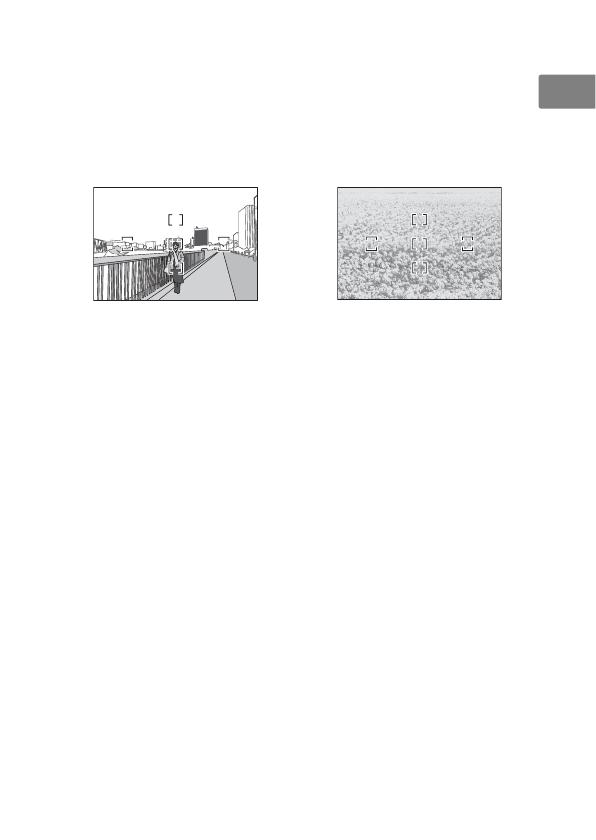Page is loading ...

14
Jp
En
De
Fr
Es
Sv
Ru
Nl
Pt
Pb
It
Cz
Sk
Ro
Ua
Ck
Ch
Kr
Id
For Your Safety
CAUTIONS
• Do not disassemble.
Touching the internal parts of the camera or lens
could result in injury.
In the event of malfunction, the product should
be repaired only by a qualified technician.
Should the product break
open as the result of a fall or other accident, remove the camera battery
and/or disconnect the AC adapter and then take the product to a
Nikon-authorized service center for inspection.
• Turn the camera off immediately in the event of malfunction.
Should you
notice smoke or an unusual smell coming from the equipment,
immediately unplug the AC adapter and remove the camera battery,
taking care to avoid burns.
Continued operation could result in fire or
injury.
After removing the battery, take the equipment to a Nikon-
authorized service center for inspection.
• Do not use in the presence of flammable gas.
Operating electronic
equipment in the presence of flammable gas could result in explosion
or fire.
• Do not look at the sun through the lens or the camera viewfinder.
Viewing the
sun or other bright light source through the lens or viewfinder could
cause permanent visual impairment.
• Keep out of reach of children.
Failure to observe this precaution could
result in injury.
• Observe the following precautions when handling the lens and camera:
-Keep the lens and camera dry.
Failure to observe this precaution
could result in fire or electric shock.
- Do not handle the lens or camera with wet hands.
Failure to observe
this precaution could result in electric shock.
- Keep the sun well out of the frame when shooting backlit subjects.
Sunlight focused into the camera when the sun is in or close to the
frame could cause a fire.
- If the lens will not be used for an extended period, attach the front
and rear lens caps and store the lens out of direct sunlight.
If left in
direct sunlight, the lens could focus the sun’s rays onto flammable
objects, causing fire.
• Do not carry tripods with a lens or camera attached.
You could trip or
accidentally strike others, resulting in injury.
• Do not leave the lens where it will be exposed to extremely high temperatures,
such as in an enclosed automobile or in direct sunlight.
Failure to observe this
precaution could adversely affect the lens’ internal parts, causing fire.

15
Jp
En
De
Fr
Es
Sv
Ru
Nl
Pt
Pb
It
Cz
Sk
Ro
Ua
Ck
Ch
Kr
Id
Thank you for your purchase of an AF-S DX NIKKOR 18–300mm f/3.5–
5.6G ED VR lens.
Before using this product, please carefully read both
these instructions and the camera manual.
Note: DX lenses are for use only with DX-format digital single-lens reflex
cameras such as the D7000 or D300 series.
The angle of view of a lens on
a DX-format camera is equivalent to that of a lens with a focal length
about 1.5 × longer mounted on a 35 mm format camera.
■ Parts of the Lens
we r ty ou!0i!1 !2 !3
!4
!5
!6
!7
q
q Lens hood...........................................20
w Lens hood alignment mark .....20
e Lens hood lock mark....................20
r Lens hood mounting mark......20
t Zoom ring...........................................16
y Focal length scale..........................16
u Focal length mark
i Focus distance indicator
o Focus distance mark
!0 Focus ring........................................... 17
!1 Lens mounting mark
!2 Rubber lens-mount gasket ..... 21
!3 CPU contacts.................................... 21
!4 Focus-mode switch .....................17
!5 Vibration reduction ON/OFF
switch.............................................. 18
!6 Vibration reduction mode
switch.............................................. 18
!7 Zoom lock..........................................16

16
Jp
En
De
Fr
Es
Sv
Ru
Nl
Pt
Pb
It
Cz
Sk
Ro
Ua
Ck
Ch
Kr
Id
■ Zoom and Depth of Field
Before focusing, rotate the zoom ring to adjust the focal length and
frame the photograph.
If the camera offers depth-of-field preview
(stop down), depth of field can be previewed in the viewfinder.
Note: Focal length decreases as the focus distance shortens.
Note that
the focus distance indicator is intended only as a guide and may not
accurately show the distance to the subject and may, due to depth of
field or other factors, not show ∞ when the camera is focused on a
distant object.
To lock the zoom ring, rotate it to the 18 mm position and slide the
zoom lock to LOCK.
This prevents the lens extending under its own
weight while the camera is being carried from place to place.
■ Aperture
Aperture is adjusted using camera controls.
Zoom and Maximum Aperture
Changes to zoom can alter the maximum aperture by up to 1
1
/
3
EV.
The camera however automatically takes this into account when
setting exposure, and no modifications to camera settings are
required following adjustments to zoom.

17
Jp
En
De
Fr
Es
Sv
Ru
Nl
Pt
Pb
It
Cz
Sk
Ro
Ua
Ck
Ch
Kr
Id
■ Focus
Supported focus modes are shown in the following table (for
information on camera focus modes, see the camera manual; for
information on getting good results with autofocus, see “A Note on
Wide- and Super Wide-Angle Lenses” on page 23).
M/A (Autofocus with Manual Override)
To focus using autofocus with manual override (M/A):
■ Vibration Reduction (VRII)
Vibration reduction (VRII) reduces blur caused by camera shake,
allowing shutter speeds up to four stops slower than would otherwise
be the case (Nikon measurements; effects vary with the photographer
and shooting conditions).
This increases the range of shutter speeds
available and permits hand-held, tripod-free photography in a wide
range of situations.
Camera
focus mode
Lens focus mode
M/A M
AF
Autofocus with manual
override
Manual focus with electronic
rangefinder
MF Manual focus with electronic rangefinder
z
Slide the lens focus-mode switch to M/A.
x
Focus.
If desired, autofocus can be over-ridden by rotating the lens focus
ring while the shutter-release button is pressed halfway (or, if the
camera is equipped with an AF-ON button, while the AF-ON
button is pressed).
To refocus using autofocus, press the shutter-
release button halfway or press the AF-ON button again.

18
Jp
En
De
Fr
Es
Sv
Ru
Nl
Pt
Pb
It
Cz
Sk
Ro
Ua
Ck
Ch
Kr
Id
Choose from NORMAL and ACTIVE vibration reduction according to
the frequency and amplitude of the vibration.
• Camera shake: Choose NORMAL or ACTIVE.
• Shooting while panning: Choose NORMAL.
• Strong camera shake: Choose ACTIVE.
Using the Vibration Reduction ON/OFF Switch
Using the Vibration Reduction Mode Switch
The vibration reduction mode switch is used to select the vibration
reduction mode when vibration reduction is on.
High Frequency Low
Low Amplitude High
: Suited to NORMAL vibration reduction.
: Suited to ACTIVE vibration reduction.
Select ON to enable vibration reduction.
Vibration reduction
is activated when the shutter-release button is pressed
halfway, reducing the effects of camera shake for
improved framing and focus.
Select OFF to turn vibration reduction off.
Select NORMAL to reduce vibration caused by camera
shake or when panning the camera.
Select ACTIVE to reduce vibration caused by camera
shake or when shooting from a moving car, boat, or
other unstable platform.
Panning motions are not
detected.
Strong
camera shake
(e.g., moving
vehicle)
Camera shake
Shooting while panning

19
Jp
En
De
Fr
Es
Sv
Ru
Nl
Pt
Pb
It
Cz
Sk
Ro
Ua
Ck
Ch
Kr
Id
Using Vibration Reduction: Notes
• When using vibration reduction, press the shutter-release button
halfway and wait for the image in the viewfinder to stabilize before
pressing the shutter-release button the rest of the way down.
• When vibration reduction is active, the image in the viewfinder may
be blurred after the shutter is released.
This does not indicate a
malfunction.
• Slide the vibration reduction mode switch to NORMAL for panning
shots.
When the camera is panned, vibration reduction applies only
to motion that is not part of the pan (if the camera is panned
horizontally, for example, vibration reduction will be applied only to
vertical shake), making it much easier to pan the camera smoothly in
a wide arc.
• Do not turn the camera off or remove the lens while vibration
reduction is in effect.
If power to the lens is cut while vibration
reduction is on, the lens may rattle when shaken.
This is not a
malfunction, and can be corrected by reattaching the lens and
turning the camera on.
• If the camera is equipped with a built-in flash, vibration reduction
will be disabled while the flash charges.
• If the camera is equipped with an AF-ON button, pressing the
AF-ON button will not activate vibration reduction.
• Turn vibration reduction off when the camera is securely mounted
on a tripod, but leave it on if the tripod head is not secured or when
using a monopod.

20
Jp
En
De
Fr
Es
Sv
Ru
Nl
Pt
Pb
It
Cz
Sk
Ro
Ua
Ck
Ch
Kr
Id
■ The Lens Hood
The lens hoods protect the lens and block stray light that would
otherwise cause flare or ghosting.
When attaching or removing the hood, hold it near the symbol on
its base and avoid gripping it too tightly.
Vignetting may occur if the
hood is not correctly attached.
The hood can be reversed and mounted on the lens when not in use.
When the hood is reversed, it can be attached and removed by rotating
it while holding it near the lock mark (
—
{
).
■ Built-in Flash Units
When using the built-in flash on cameras equipped with a built-in
flash unit, shoot at ranges of 0.6 m (2 ft) or more and remove the lens
hood to prevent vignetting (shadows created where the end of the
lens obscures the built-in flash).
Align the lens hood lock mark (—
{) with
the lens hood mounting mark (●) on the
lens (e).
Camera Focal length Use at ranges of
D800 series (DX format)
18 mm 3.0 m (9 ft 10 in.) or more
28 mm 1.0 m (3 ft 3 in.) or more
50 mm or more No restrictions
D700 (DX format)
18 mm 3.0 m (9 ft 10 in.) or more
28 mm or more No restrictions
D7000/D300 series/D200
28 mm 1.0 m (3 ft 3 in.) or more
50 mm or more No restrictions
D100
28 mm 1.5 m (4 ft 11 in.) or more
50 mm or more No restrictions
D90/D80/D70 series
28 mm 2.5 m (8 ft 2 in.) or more
50 mm or more 1.0 m (3 ft 3 in.) or more
D5100/D5000/D3100/
D3000/D60/D40 series
50 mm or more 1.0 m (3 ft 3 in.) or more
D50
28 mm 2.0 m (6 ft 7 in.) or more
50 mm or more 1.0 m (3 ft 3 in.) or more

21
Jp
En
De
Fr
Es
Sv
Ru
Nl
Pt
Pb
It
Cz
Sk
Ro
Ua
Ck
Ch
Kr
Id
■ Lens Care
• Do not pick up or hold the lens or camera using only the lens hood.
• Keep the CPU contacts clean.
• Should the rubber lens-mount gasket be damaged, cease use
immediately and take the lens to a Nikon-authorized service center
for repair.
• Use a blower to remove dust and lint from the lens surfaces.
To
remove smudges and fingerprints, apply a small amount of ethanol
or lens cleaner to a soft, clean cotton cloth or lens-cleaning tissue
and clean from the center outwards using a circular motion, taking
care not to leave smears or touch the glass with your fingers.
• Never use organic solvents such as paint thinner or benzene to clean
the lens.
• The lens hood or NC filters can be used to protect the front lens
element.
• Attach the front and rear caps before placing the lens in its flexible
pouch.
• If the lens will not be used for an extended period, store it in a cool,
dry location to prevent mold and rust.
Do not store in direct sunlight
or with naphtha or camphor moth balls.
•Keep the lens dry.
Rusting of the internal mechanism can cause
irreparable damage.
• Leaving the lens in extremely hot locations could damage or warp
parts made from reinforced plastic.
■ Supplied Accessories
• 77 mm snap-on Front Lens Cap LC-77
• Rear Lens Cap LF-4
• Bayonet Hood HB-58
• Flexible Lens Pouch CL-1120
■ Compatible Accessories
• 77 mm screw-on filters

22
Jp
En
De
Fr
Es
Sv
Ru
Nl
Pt
Pb
It
Cz
Sk
Ro
Ua
Ck
Ch
Kr
Id
■ Specifications
Nikon reserves the right to change the specifications of the hardware
described in this manual at any time and without prior notice.
Type Type G AF-S DX lens with built-in CPU and
Fmount
Focal length 18–300 mm
Maximum aperture f/3.5–5.6
Lens construction 19 elements in 14 groups (including 3 aspherical lens
elements and 3 ED lens elements)
Angle of view
76°–5° 20 ′
Focal length scale Graduated in millimeters (18, 28, 50, 105, 200, 300)
Distance information Output to camera
Zoom
Manual zoom using independent zoom ring
Focusing
Nikon Internal Focusing (IF) System with
autofocus controlled by Silent Wave Motor and
separate focus ring for manual focus
Vibration reduction Lens shift using voice coil motors (VCMs)
Focus distance indicator 0.45 m to infinity (∞)
Minimum focus distance
300 mm focal length: 0.45 m (1.48 ft) from focal
plane
Diaphragm blades 9 (rounded diaphragm opening)
Diaphragm Fully automatic
Aperture range
• 18 mm focal length: f/3.5 to f/22
• 300 mm focal length: f/5.6 to f/32
Metering Full aperture
Filter-attachment size 77 mm (P=0.75 mm)
Dimensions Approx. 83 mm diameter × 120 mm (distance from
camera lens mount flange)
Weight Approx. 830 g (29.3 oz)

23
Jp
En
De
Fr
Es
Sv
Ru
Nl
Pt
Pb
It
Cz
Sk
Ro
Ua
Ck
Ch
Kr
Id
■ A Note on Wide- and Super Wide-Angle Lenses
Autofocus may not provide the desired results with wide- and super
wide-angle lenses in the following situations:
1 The subject does not fill the area enclosed by the focus brackets.
If the focus point contains both foreground and background objects,
the camera may focus on the background and the subject may be
out of focus.
2 The subject contains many fine details.
The camera may have difficulty focusing on subjects that contain
many fine details or that are lacking in contrast.
In these cases, use manual focus, or use focus lock to focus on another
subject at the same distance and then recompose the photograph.
For more information, see “Getting Good Results with Autofocus” in
the camera manual.
Example 1: A far-off portrait subject
at some distance from the
background Example 2: A field of flowers

187
Jp
En
De
Fr
Es
Sv
Ru
Nl
Pt
Pb
It
Cz
Sk
Ro
Ua
Ck
Ch
Kr
Id
/